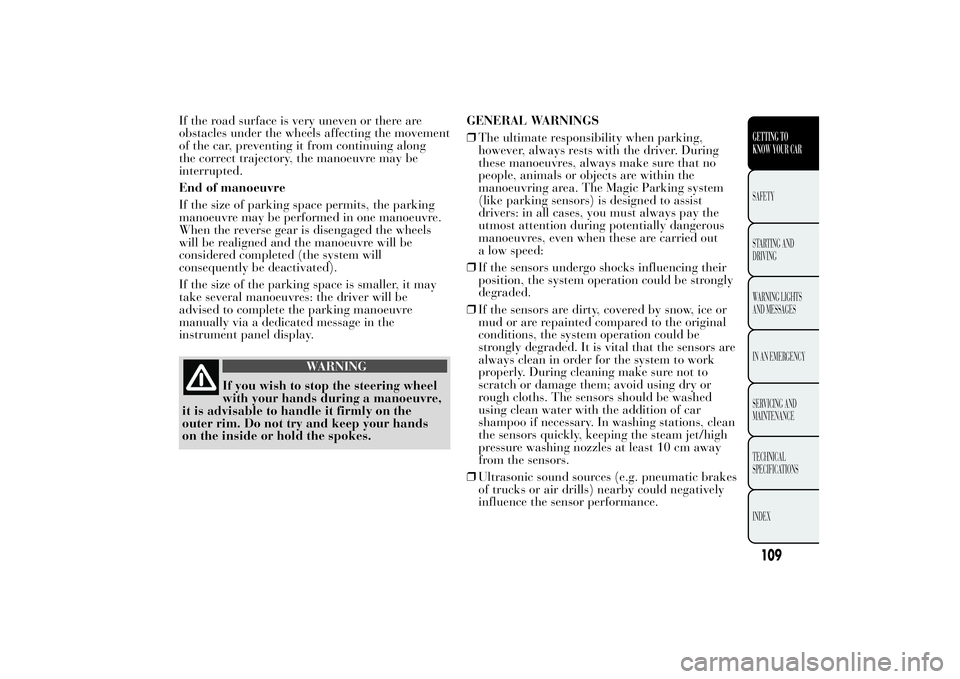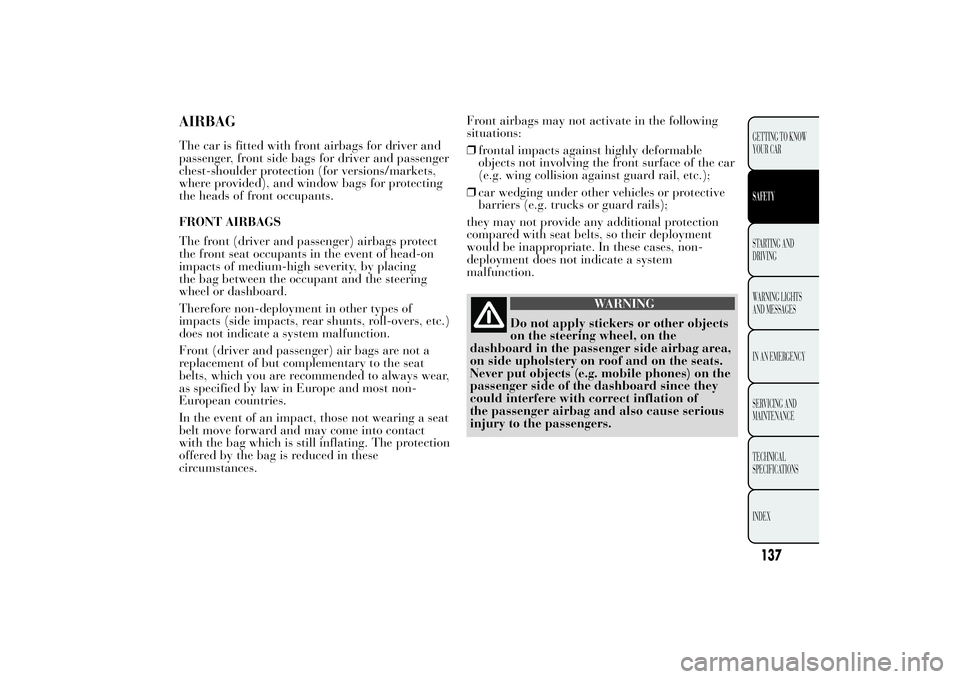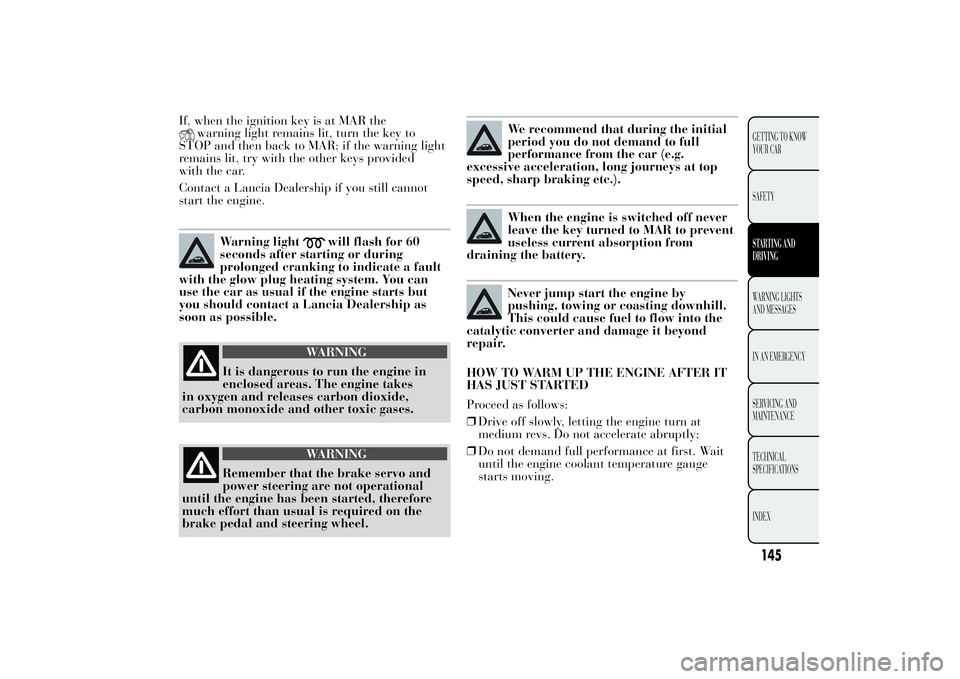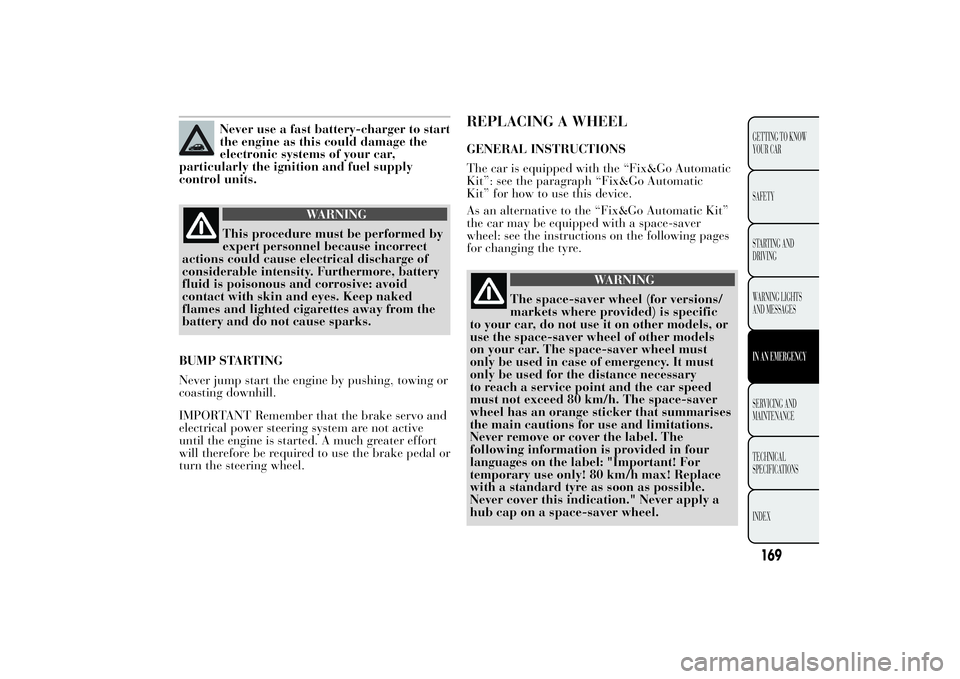Steering wheel Lancia Ypsilon 2012 Owner handbook (in English)
[x] Cancel search | Manufacturer: LANCIA, Model Year: 2012, Model line: Ypsilon, Model: Lancia Ypsilon 2012Pages: 307, PDF Size: 13.3 MB
Page 107 of 307

OPERATION
The assisted parking manoeuvre can only be
activated with the instrument panel on and at
speeds below about 30 km/h and consists of the
following stages:❒Activation:pressing the button
starts the
search.
❒Search:through side sensors, the system
continuously searches for a free parking space,
suitable for the car's dimensions. The driver
chooses on which side of the road they intend to
park using the direction indicators (if no
information is available from the direction
indicators or hazard warning lights, the search
takes place on the passenger side).
IMPORTANT The SEARCHING is disabled if,
after about 10 minutes, a suitable parking space
has not been found.
❒Identification:if the system identifies a free
parking space that is a suitable size for the
car, it signals its presence and indicates
the actions required for starting the manoeuvre.
❒Manoeuvre:the driver is asked to engage
reverse gear, release the steering wheel and
manage the accelerator, brake and clutch (in the
case of manual gearbox) or accelerator and
brake (in the case of automatic gearbox) (for
versions/markets, where provided). During the
reverse parking manoeuvre, the system manages
the steering wheel automatically. According to
the parking space, the manoeuvre may end
through reversing or further manoeuvres, both
in forward gear and in reverse, may be
necessary. After the first manoeuvre, when the
rear buzzer sounds continuously, the driver
is requested to disengage reverse and engage the
forward gear. If this is not enough, when the
fig. 80
L0F0036
fig. 81
L0F0037
105GETTING TO
KNOW YOUR CARSAFETY
STARTING AND
DRIVING
WARNING LIGHTS
AND MESSAGES
IN AN EMERGENCY
SERVICING AND
MAINTENANCE
TECHNICAL
SPECIFICATIONS
INDEX
Page 108 of 307

continuous tone is reached, the driver is
requested to engage reverse. The semi-
automatic manoeuvre ends when the display
shows the message "End manually".
❒Conclusion:at the end of the manoeuvre, the
driver resumes control and, if necessary, has to
complete parking manually.
IMPORTANT MANOEUVRING is disabled if,
after 3 minutes, parking has not been completed.
IMPORTANT Steering will be realigned after
reversing when reverse gear is disengaged. The
driver must complete the manoeuvre manually.
The Magic Parking operation is based
on various components: front and
rear parking sensors, side sensors,
steering system, wheels and braking system,
instrument panel. Bear in mind that
malfunction of one of these components could
compromise the operation of the system.
DESCRIPTION OF MANOEUVRING STAGES
Activation
The system is activated by pressing button
:as
soon as it is activated, the system starts searching
(the switching on of the LED on the button
indicates that the system is active).Since the system recognises parking spaces even
when it is deactivated, the system can be activated
straight away after having driven past an
adjacent parking space that is deemed suitable.
If the system has identified a parking space,
searching will not be performed and the system
will notify the driver of the operations required to
carry out the manoeuvre correctly through the
instrument panel display.
Search for a parking space
While searching fig. 82 the car should continue
following its route at a speed of below 30 km/h
and at a distance of around 50 cm to 130 cm from
parked cars. A parking space is considered
suitable if it is about 80 cm longer than the
dimensions of the car.
fig. 82
L0F1001
106GETTING TO
KNOW YOUR CAR
SAFETY
STARTING AND
DRIVING
WARNING LIGHTS
AND MESSAGES
IN AN EMERGENCY
SERVICING AND
MAINTENANCE
TECHNICAL
SPECIFICATIONS
INDEX
Page 111 of 307

If the road surface is very uneven or there are
obstacles under the wheels affecting the movement
of the car, preventing it from continuing along
the correct trajectory, the manoeuvre may be
interrupted.
End of manoeuvre
If the size of parking space permits, the parking
manoeuvre may be performed in one manoeuvre.
When the reverse gear is disengaged the wheels
will be realigned and the manoeuvre will be
considered completed (the system will
consequently be deactivated).
If the size of the parking space is smaller, it may
take several manoeuvres: the driver will be
advised to complete the parking manoeuvre
manually via a dedicated message in the
instrument panel display.
WARNING
If you wish to stop the steering wheel
with your hands during a manoeuvre,
it is advisable to handle it firmly on the
outer rim. Do not try and keep your hands
on the inside or hold the spokes.GENERAL WARNINGS
❒The ultimate responsibility when parking,
however, always rests with the driver. During
these manoeuvres, always make sure that no
people, animals or objects are within the
manoeuvring area. The Magic Parking system
(like parking sensors) is designed to assist
drivers: in all cases, you must always pay the
utmost attention during potentially dangerous
manoeuvres, even when these are carried out
a low speed:
❒If the sensors undergo shocks influencing their
position, the system operation could be strongly
degraded.
❒If the sensors are dirty, covered by snow, ice or
mud or are repainted compared to the original
conditions, the system operation could be
strongly degraded. It is vital that the sensors are
always clean in order for the system to work
properly. During cleaning make sure not to
scratch or damage them; avoid using dry or
rough cloths. The sensors should be washed
using clean water with the addition of car
shampoo if necessary. In washing stations, clean
the sensors quickly, keeping the steam jet/high
pressure washing nozzles at least 10 cm away
from the sensors.
❒Ultrasonic sound sources (e.g. pneumatic brakes
of trucks or air drills) nearby could negatively
influence the sensor performance.
109GETTING TO
KNOW YOUR CARSAFETY
STARTING AND
DRIVING
WARNING LIGHTS
AND MESSAGES
IN AN EMERGENCY
SERVICING AND
MAINTENANCE
TECHNICAL
SPECIFICATIONS
INDEX
Page 113 of 307

MESSAGES ON THE DISPLAY
Search in progress:the Magic Parking system is
searching for a suitable parking space.
Parking found:the Magic Parking system has
found a suitable parking space.
Drive forward:the Magic Parking system
requests the driver to proceed slowly to bring the
car to the correct position before starting the
semi-automatic manoeuvre or, during the
semi-automatic manoeuvre, the system requests
the driver to engage the forward gear to continue
the manoeuvre.
Engaging reverse:a suitable parking place has
been found and the position is correct for starting
the parking manoeuvre. Stop and engage reverse.
Disengage reverse:when the Magic Parking
activation button is pressed, reverse gear must be
released for the system to be switched on.
Magic Parking: steering wheel being usedThe
manoeuvre is about to begin, the driver is
requested to release the steering wheel.
Drive backwards - Magic Parking: steering
wheel being used:The manoeuvre has started,
the driver can accelerate and release the clutch (in
the case of a manual gearbox) to enter the parking
space. The system manages the steering
automatically.Speed too high:The speed of the car is about to
exceed the maximum speed permitted by the
system (the message will be displayed at about 25
km/h for the search stage). If the speed is
increased further, the system will be deactivated
automatically.
Magic Parking not available:A problem has
been detected in the system. In this case, go to a
Lancia Dealership.
Try again later:The Magic Parking system has
detected a problem in one of the systems required
for its operation. If the problem persists, go to a
Lancia Dealership.
Action on the steering wheel:The driver has
voluntarily or involuntarily operated the steering
wheel. The system is disabled and the manoeuvre
is controlled by the driver again.
Magic Parking OFF:The system is deactivated
for one of the following conditions: manoeuvre
concluded, speed limits exceeded, presence of
a trailer, search stage too long, manoeuvre stage
too long, use of parking sensors requested during
the search stage, incorrect car trajectory as a result
of obstacles at the wheels.
End Manually:
❒The initial parking stage managed by system
has ended, but the parking manoeuvre must
be completed by the driver.
❒The steering wheel has been grasped during the
manoeuvre.
111GETTING TO
KNOW YOUR CARSAFETY
STARTING AND
DRIVING
WARNING LIGHTS
AND MESSAGES
IN AN EMERGENCY
SERVICING AND
MAINTENANCE
TECHNICAL
SPECIFICATIONS
INDEX
Page 139 of 307

AIRBAGThe car is fitted with front airbags for driver and
passenger, front side bags for driver and passenger
chest-shoulder protection (for versions/markets,
where provided), and window bags for protecting
the heads of front occupants.
FRONT AIRBAGS
The front (driver and passenger) airbags protect
the front seat occupants in the event of head-on
impacts of medium-high severity, by placing
the bag between the occupant and the steering
wheel or dashboard.
Therefore non-deployment in other types of
impacts (side impacts, rear shunts, roll-overs, etc.)
does not indicate a system malfunction.
Front (driver and passenger) air bags are not a
replacement of but complementary to the seat
belts, which you are recommended to always wear,
as specified by law in Europe and most non-
European countries.
In the event of an impact, those not wearing a seat
belt move forward and may come into contact
with the bag which is still inflating. The protection
offered by the bag is reduced in these
circumstances.Front airbags may not activate in the following
situations:
❒frontal impacts against highly deformable
objects not involving the front surface of the car
(e.g. wing collision against guard rail, etc.);
❒car wedging under other vehicles or protective
barriers (e.g. trucks or guard rails);
they may not provide any additional protection
compared with seat belts, so their deployment
would be inappropriate. In these cases, non-
deployment does not indicate a system
malfunction.
WARNING
Do not apply stickers or other objects
on the steering wheel, on the
dashboard in the passenger side airbag area,
on side upholstery on roof and on the seats.
Never put objects (e.g. mobile phones) on the
passenger side of the dashboard since they
could interfere with correct inflation of
the passenger airbag and also cause serious
injury to the passengers.
137GETTING TO KNOW
YOUR CARSAFETYSTARTING AND
DRIVING
WARNING LIGHTS
AND MESSAGES
IN AN EMERGENCY
SERVICING AND
MAINTENANCE
TECHNICAL
SPECIFICATIONS
INDEX
Page 140 of 307

Driver side front airbag
This consists of an instantly inflating bag
contained in a special compartment in the centre
of the steering wheel fig. 108.
WARNING
Always drive keeping your hands on
the steering wheel rim so that the
airbag can inflate freely if necessary. Do not
drive with your body bent forward. Keep
your back straight against the backrest.Passenger side front airbag
This consists of an instantly-inflating bag
contained in a special compartment in the
dashboard fig. 109: this bag has a larger volume
than that on the driver's side.
fig. 108
L0F0072
fig. 109
L0F0073
138
GETTING TO KNOW
YOUR CAR
SAFETY
STARTING AND
DRIVING
WARNING LIGHTS
AND MESSAGES
IN AN EMERGENCY
SERVICING AND
MAINTENANCE
TECHNICAL
SPECIFICATIONS
INDEX
Page 147 of 307

If, when the ignition key is at MAR the
warning light remains lit, turn the key to
STOP and then back to MAR; if the warning light
remains lit, try with the other keys provided
with the car.
Contact a Lancia Dealership if you still cannot
start the engine.
Warning light
will flash for 60
seconds after starting or during
prolonged cranking to indicate a fault
with the glow plug heating system. You can
use the car as usual if the engine starts but
you should contact a Lancia Dealership as
soon as possible.
WARNING
It is dangerous to run the engine in
enclosed areas. The engine takes
in oxygen and releases carbon dioxide,
carbon monoxide and other toxic gases.
WARNING
Remember that the brake servo and
power steering are not operational
until the engine has been started, therefore
much effort than usual is required on the
brake pedal and steering wheel.
We recommend that during the initial
period you do not demand to full
performance from the car (e.g.
excessive acceleration, long journeys at top
speed, sharp braking etc.).When the engine is switched off never
leave the key turned to MAR to prevent
useless current absorption from
draining the battery.Never jump start the engine by
pushing, towing or coasting downhill.
This could cause fuel to flow into the
catalytic converter and damage it beyond
repair.
HOW TO WARM UP THE ENGINE AFTER IT
HAS JUST STARTED
Proceed as follows:
❒Drive off slowly, letting the engine turn at
medium revs. Do not accelerate abruptly;
❒Do not demand full performance at first. Wait
until the engine coolant temperature gauge
starts moving.
145GETTING TO KNOW
YOUR CAR
SAFETYSTARTING AND
DRIVINGWARNING LIGHTS
AND MESSAGES
IN AN EMERGENCY
SERVICING AND
MAINTENANCE
TECHNICAL
SPECIFICATIONS
INDEX
Page 164 of 307

“DUALDRIVE” ELECTRIC POWER
STEERING FAILURE (red)
This warning light switches on when the ignition
key is turned to MAR, but it should switch off
after a few seconds.
If the warning light (or, on some versions, a
message and a symbol on the display) remains on,
you may not have steering assistance and the
effort required to operate the steering wheel could
be notably increased; steering is, however,
possible. In this case, contact a Lancia Dealership.
IMPORTANT In some circumstances, factors
independent of the electric power steering could
cause the warning light on the instrument panel to
switch on. In this case, stop the car immediately,
switch off the engine for about 20 seconds and
then restart the engine. If the warning light (or, on
some versions, a message and a symbol on the
display) remains on constantly, contact a Lancia
Dealership.
IMPORTANT After the battery is disconnected,
the steering must be initialised. The warning light
switches on to indicate this. To carry out this
procedure, simply turn the steering wheel all the
way from one end to the other or drive in a
straight line for about a hundred metres.
CRUISE CONTROL (green)
(for versions/markets, where provided)
This warning light switches on when the ignition
key is turned to MAR, but it should switch off
after a few seconds, if the Cruise Control is
deactivated.
The warning light switches on when the Cruise
Control ring nut is turned to the ON position (see
the “Cruise Control” paragraph in the "Knowing
your car" section). On some versions the display
shows the dedicated message.DPF (PARTICULATE FILTER) BEING
CLEANED
(only Diesel versions with DPF) (amber)
Turning the key to the MAR-ON position
illuminates the warning light, but it should switch
off after a few seconds.
The warning light (together with a message and a
symbol on the display on some versions) switches
on constantly to notify the driver that the DPF
system needs to eliminate captured pollutants
(particulate) through the regeneration process.
162
GETTING TO KNOW
YOUR CAR
SAFETY
STARTING AND
DRIVINGWARNING LIGHTS
AND MESSAGESIN AN EMERGENCY
SERVICING AND
MAINTENANCE
TECHNICAL
SPECIFICATIONS
INDEX
Page 171 of 307

Never use a fast battery-charger to start
the engine as this could damage the
electronic systems of your car,
particularly the ignition and fuel supply
control units.
WARNING
This procedure must be performed by
expert personnel because incorrect
actions could cause electrical discharge of
considerable intensity. Furthermore, battery
fluid is poisonous and corrosive: avoid
contact with skin and eyes. Keep naked
flames and lighted cigarettes away from the
battery and do not cause sparks.
BUMP STARTING
Never jump start the engine by pushing, towing or
coasting downhill.
IMPORTANT Remember that the brake servo and
electrical power steering system are not active
until the engine is started. A much greater effort
will therefore be required to use the brake pedal or
turn the steering wheel.
REPLACING A WHEELGENERAL INSTRUCTIONS
The car is equipped with the “Fix&Go Automatic
Kit”: see the paragraph “Fix&Go Automatic
Kit” for how to use this device.
As an alternative to the “Fix&Go Automatic Kit”
the car may be equipped with a space-saver
wheel: see the instructions on the following pages
for changing the tyre.
WARNING
The space-saver wheel (for versions/
markets where provided) is specific
to your car, do not use it on other models, or
use the space-saver wheel of other models
on your car. The space-saver wheel must
only be used in case of emergency. It must
only be used for the distance necessary
to reach a service point and the car speed
must not exceed 80 km/h. The space-saver
wheel has an orange sticker that summarises
the main cautions for use and limitations.
Never remove or cover the label. The
following information is provided in four
languages on the label: "Important! For
temporary use only! 80 km/h max! Replace
with a standard tyre as soon as possible.
Never cover this indication." Never apply a
hub cap on a space-saver wheel.
169GETTING TO KNOW
YOUR CAR
SAFETY
STARTING AND
DRIVING
WARNING LIGHTS
AND MESSAGESIN AN EMERGENCYSERVICING AND
MAINTENANCE
TECHNICAL
SPECIFICATIONS
INDEX
Page 204 of 307

WARNING
Before towing, turn the ignition key to
MAR and then to STOP without
removing it. The steering column will
automatically lock when the key is removed
and the wheels cannot be steered.
WARNING
Before tightening the hook clean the
threaded housing thoroughly. Make
sure that the hook is fully fastened in the
housing before towing the car.
WARNING
Whilst towing, remember that as the
assistance of the brake servo and
the electric power assisted steering is not
available, greater force needs to be exerted
on the brake pedal and more effort is
required on the steering wheel. Do not use
flexible cables when towing and avoid jerky
movements. During towing, make sure that
the trailer hitch does not damage any
components it is touching. When towing the
car, it is compulsory to respect specific
highway code regulations relating to the tow
hook and procedures for towing on the
road. Do not start the engine while towing
the car.
fig. 161
L0F0022
202
GETTING TO KNOW
YOUR CAR
SAFETY
STARTING AND
DRIVING
WARNING LIGHTS
AND MESSAGESIN AN EMERGENCYSERVICING AND
MAINTENANCE
TECHNICAL
SPECIFICATIONS
INDEX